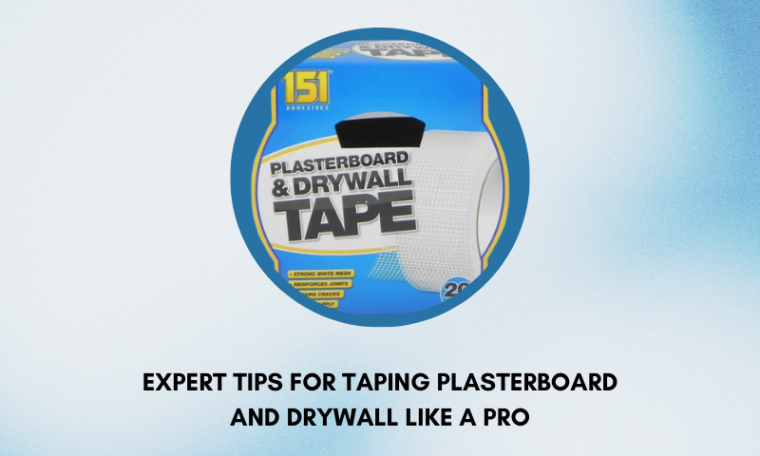
Introduction:
Are you interested in making out your wall taping with plasterboard? Check here it out it will help you save almost about $100.
You don’t need to get involved in techniques like handling nail pops, bad joints, etc.
Here you can follow some of the steps and make pro like plasterboard and drywall tape.
A guide to follow for the smooth drywall
Taping a drywall completely might give you a frustrating type of experience. If not done perfectly would develop a crack even after months.
Therefore, it is important to make a perfect smooth drywall. The main issue created might come up with bad joints, nail pops, corner bead cracks, and more.
To avoid all such hazel at the last moment you can follow up on this guide. Here you can follow some of the basic steps to perfectly tape up your drywall. Gather up the tools and materials and let set to see how easy it gets to tape your wall.
You would already know that taping a wall up demands much of the money from your pockets. Here you can also learn some of the steps to avoid mistakes while dealing with smooth drywall.
Grab up the drywall tools
Do you frequently come across drywall tools? If yes, then in this case you can own a tool or even go with a rented one. There are many shops available with an entire kit for the drywall tools.
But in real you won’t need all of those and results in a waste of time. Only just make the list of tools that would make your work without any reason.
- four-inch putty knife
- six-inch putty knife
- potato masher
- A clincher
- A 12 in trowel
- A banjo
Understanding the Basics:
Before diving into the tips, it’s crucial to understand the basics of plasterboard and drywall taping.
Taping is the process of concealing joints and seams between sheets of plasterboard or drywall to create a smooth and even surface.
The goal is to make these joints disappear, leaving behind a seamless canvas for painting or finishing.
Tip 1: Choose the Right Tape and Joint Compound:
The foundation of a well-taped plasterboard or drywall is selecting the right tape and joint compound. Use high-quality plasterboard and drywall tape, and opt for a joint compound that suits your project.
Lightweight joint compounds are easier to work with for beginners, as they offer a longer drying time, allowing for adjustments.
Tip 2: Prep the Surface Properly:
A successful taping job starts with proper surface preparation. Clean the surface of the plasterboard or drywall thoroughly, removing any dust, dirt, or debris.
Ensure that the surface is smooth and free from imperfections. Repair any cracks or dents with a joint compound before applying the tape.
Tip 3: Measure and Cut Precisely:
Accurate measurements are essential when cutting plasterboard and drywall tape. Measure the length of the joint or seam and cut the tape accordingly.
Use a sharp utility knife or scissors for clean and precise cuts. This step sets the foundation for a neat and professional-looking finish.
Tip 4: Apply an Even Layer of Joint Compound:
Before applying the tape, spread a thin and even layer of joint compound over the joint or seam. This provides a smooth surface for the tape to adhere to and helps eliminate air bubbles.
Use a putty knife or taping knife to spread the joint compound evenly, feathering the edges to blend with the surrounding surface.
Follow these steps to get the best result for drywall plasterboard
- Scrap off the drywall or loosen wall materials
Use a utility knife or paper and scrap off the excess materials from the damaged area of drywall. Remove the paper along with the gypsum core on the wall. Peel the sandpaper with the help of a sponge.
- Fill damaged area on drywall with the help of setting compound
Take a vessel and fill it with a taping compound of your choice. Mix this ingredient into the mud and mix it until you get the consistency like peanut butter.
Apply this mixture to the damaged area on the drywall. You can indeed use the 6-inch knife in a way that doesn’t make a raised level. This is because you might find things difficult to handle once the mixture dries.
- Install all corner beads
Hold the two beads in a manner that covers the wall. You may also cut the bead to make it perfect to set for the corners. Here you would need the 6-inch putty knife.
Apply the mixture and make sure to not leave any part of the corner. Now attach the beads on the drywall until it gets dry. Also, once after the application, you can make out testing for leftover parts on plasterboard and drywall tape
- Make a hole in the damaged drywall
Do you see any of the dents or cracks on the drywall after the application and drying of the mixture? If yes, then you can make out for the spot with the help of a butt placed in the knife handle.
These problems might arise with a professional taper also. Hence, you should not get worry if face such problems while dealing with drywall.
A leftover area of the corner from the mixture are cause for such issues. Therefore, you can use drywall tapes to fill of such areas for proper paint.
- Selection of the mud
You need to choose the setting type or else drying type of mud. You only need to mix ingredients along with setting compounds. These have specifically the presence of plaster of Paris for getting harder consistency.
These get dry very fast and hence as a beginner, you should only make a small amount of mixture. It will let you get more time to work properly with drywall. You need to choose the drying compound for the actual taping process.
These all come up in a premixed manner also in the market. But this taping mixture doesn’t prove the name worth it. This is because the premixed mixture is not readily available in a mixed state as soon as you open the packet.
Here you need to add the water till the desired mixture consistency. You might need to repeat this process before the first application on the drywall. A mixture for the first application doesn’t require more than a few gallons of mud.
After this, you can surely prepare the same mixture for the required coats on the plasterboard and drywall tape. Mud tends to dry off easily. To avoid this you can cover the vessel with mud using a pail. After completing the work wipe off the excess material using a sponge for removing deposits.



